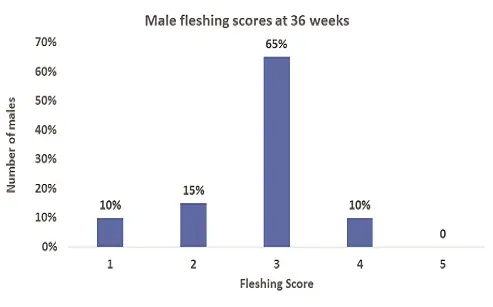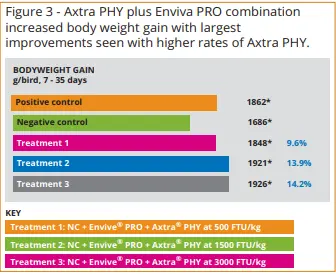As combined technologies allow producers to meet demand for high-quality protein, DuPont discusses some crucial facts about feed ingredient quality and variability, bird performance and feed cost reduction, which are vital to address typical regional challenges
While there have been significant changes in the poultry industry in recent years, bird health and disease has consistently ranked as the top two industry concerns since 2013, according to a global media survey — and for good reason.
The costs of many disease challenges are high and well documented. Necrotic enteritis alone, caused by the bacterium Clostridium perfringens, was estimated to cost the poultry industry close to US$6bn in 2015. Disease costs aside, optimal bird health remains a top concern because of its role in the efficiency by which birds convert feed into protein. With global meat consumption expected to double by 2050, gaining better value from feed, in order to deliver high-quality protein, will remain one of the biggest challenges producers face. That challenge will be compounded by shortened production cycles, variability in feed ingredients, digestibility and cost. Considering that raw feed materials make up about 70 per cent of overall production costs, innovative strategies will be required to meet the growing protein demand while remaining profitable. Several studies point to a future where the use of enzymes and probiotics in combination will be a key strategy to meet demand profitably.
The performance/feed relationship
As producers respond to pressures to reduce production costs, the quality of feed and its subsequent ease of digestibility may be sacrificed. Since optimal nutrition and a balanced gut microbiota are the two components that work in tandem to enable healthy performance, it is essential to understand how the diet and its level of digestibility affect the gut microbiota. The single biggest contributor to microbial composition and the number of non-beneficial bacterial in the intestines is the type, amount and availability of undigested nutrient substrate present in various segments of the gastrointestinal tract. Undigested nutrients flowing to the hindgut impact growth performance and directly contribute to undesirable shifts in the gut microbiota, negatively affecting feed conversion ratio (FCR) and bird health.
Unlocking nutritive value of feed
In response to the demand for decreased feed costs, feed producers may substitute corn with other crops that have less nutritive value, such as wheat, grain by-products, triticale, distiller’s dried grains with solubles (DDGS) or barley. While more affordable, these cereals are rich in non-starch polysaccharides (NSPs), which have a substantial negative impact on monogastric digestion and performance. Enzymes, which were first introduced to the poultry industry in the 1980s, are now used in more than 90 per cent of all broiler diets. Products containing xylanase, phytase, amylase, protease and other enzymes are used to improve the nutritive value of cereals containing high levels of soluble NSPs to enhance the animal’s performance to a level compared with that obtained in corn-based diets. It is generally acknowledged that the lower and more variable the feeding value of individual raw materials, the greater the potential for feed enzyme response. Appropriate combinations of feed enzymes are therefore particularly valuable in diets containing cheaper, high-fibre ingredients, which contain higher levels of anti-nutritional factors (ANFs), such as NSPs.
Enzymes can positively affect the gut microbiota by improving feed digestibility. As a group, the enzymes enhance digestion of the feed for measurable benefits like absorption of nutrients and improvements in growth uniformity in flocks.
Balanced gut microbiota
Defined as combinations of beneficial bacteria that maintain the gut microflora and assist with natural defences against non-beneficial bacteria, probiotics (DFMs in the US) are well recognised for their ability to support gut microbiota balance in animals. The microbiota plays a vital role in inhibiting the colonisation of potential pathogens, supporting immune development and providing nutrients to the host. An established microbiota helps young birds during times of stress such as transportation, changes in feed or temperature, and overuse of therapeutic antibiotics. However, the establishment of a mature and beneficial microbiota takes time.
Feeding probiotics from day one promotes the quick establishment of a positive microbiota and guards against colonisation by coliforms that may have a negative impact on performance in growing animals. Spore-forming Bacillus strains are often favoured for use in animal feed due to their ability to withstand harsh conditions during pelleting and to successfully reach the lower intestinal tract by resisting enzymatic digestion and stomach acidity. Bacillus-based probiotics have also been shown to promote the development of villi in the gut lining. Multiple trials have shown a four per cent to five per cent improvement in feed conversion when a three strain Bacillus probiotic was added to the diet. Other research using a necrotic enteritis (NE) challenge model noted that broilers maintained good performance during the challenge when probiotics were added to their feed. In the combined analysis of two NE challenge studies, a 17 point difference in FCR was seen in the challenged control versus the group fed a three-strain Bacillus-based probiotic (Figure 1). In addition, the Bacillus-fed group showed a 1.71 per cent increase in bodyweight gain and a 7.5 per cent increase in liveability compared to the challenged control.
By adding the three-strain Bacillus probiotic, bird performance returned to the unchallenged control level, mortality was reduced to 2.43 per cent and lesion scores decreased to 0.12. At 42 days, challenged birds receiving the three-strain Bacillus, experienced mortality-corrected FCR that was equivalent to a US$130,000 (based on 2016 feed prices) saving per million birds. The ability of the three-strain Bacillus to support a balanced gut microbiota will become even more important as antibiotic use is reduced.
Synergistic effects in antibiotic-free production
 Independently, enzymes and probiotics have a well-documented ability to improve healthy performance by enhancing the digestion and absorption of nutrients and promoting growth uniformity within flocks. They also show promise in studies that use them in combination with synergistic benefits. Results from multiple broiler trials conducted in antibiotic-free conditions have shown that an enzyme/probiotic combination delivers an approximate three-to-one return on investment, even for low challenge birds, due to improved digestibility and gut health. Also, a 2.5 per cent improvement was seen when phytase, xylanase, amylase, protease and three-strain Bacillus were used in combination, instead of an antibiotic growth promoter (AGP). One trial, conducted at the Poultry Research Foundation, Sydney University, showed additional performance and digestibility improvements in broilers that were fed wheat-based diets containing Axtra XB (xylanase and beta-glucanase) as well as the three-strain Bacillus Enviva PRO, when compared to the diet containing just enzymes (Figure 2).
Independently, enzymes and probiotics have a well-documented ability to improve healthy performance by enhancing the digestion and absorption of nutrients and promoting growth uniformity within flocks. They also show promise in studies that use them in combination with synergistic benefits. Results from multiple broiler trials conducted in antibiotic-free conditions have shown that an enzyme/probiotic combination delivers an approximate three-to-one return on investment, even for low challenge birds, due to improved digestibility and gut health. Also, a 2.5 per cent improvement was seen when phytase, xylanase, amylase, protease and three-strain Bacillus were used in combination, instead of an antibiotic growth promoter (AGP). One trial, conducted at the Poultry Research Foundation, Sydney University, showed additional performance and digestibility improvements in broilers that were fed wheat-based diets containing Axtra XB (xylanase and beta-glucanase) as well as the three-strain Bacillus Enviva PRO, when compared to the diet containing just enzymes (Figure 2).
Another trial, conducted at Purdue University, evaluated the performance and nutrient digestibility benefits of combining the enzyme phytase Axtra PHY and the three-strain Bacillus Enviva PRO in a corn/ soybean meal diet. While significant performance improvements were seen at every dose, the best performance gains were seen with higher enzyme doses, exhibiting the compatibility of the products (Figure 3). Improvements in digestible calcium and phosphorus were seen from another trial that combined the three-strain Bacillus Enviva PRO with Axtra XB and Axtra XAP (xylanase, amylase and protease). Performed at the Poultry Research Foundation, Sydney University, a 55.9 per cent increase in digestible calcium and a 26.9 per cent increase in digestible phosphorus were measured at the highest studied doses (50 g/t Axtra XAP + (75000 CFU/g feed) Enviva PRO).
Market conditions drive synergistic solutions
Volatile feed conditions reduced antibiotic use and increasing pressures to reduce production costs have collided, creating a demand for innovative solutions aimed at unlocking the full nutritive potential in the feed. The synergistic benefits of enzymes and probiotics have proven to be a notable way for producers to realise performance and digestibility improvements, and flock uniformity — all while enjoying a substantial return on investment.
About DuPont and Danisco Animal Nutrition
DuPont is one of the most successful science and engineering companies in the world, with a history spanning more than 200 years.
For several decades, Danisco Animal Nutrition (part of DuPont) has helped animal producers resolve ”profit, performance and planet” challenges and maximise the return on their feed investment through the delivery of optimised feed enzyme, betaine and probiotic technologies. Its uniqueness centres on our ability to deliver value-driven healthy nutrition based on combining these technologies.
Increasing the efficiency by which animals convert feed into protein and shortening the cycle time of production has become increasingly important in the last decade as traditional feed costs, already making up approximately 70 per cent of budgets, rise in response to escalating demand for meat, fish, egg and dairy products.
As research clarifies the negative effects that volatility and modern diets can have on animal digestion, we have developed unique solutions that radically reduce feed and waste management costs, while also supporting gut health and enhanced animal performance.
To learn more about Danisco Animal Nutrition and how we can help African farmers, Feed and Premix producers, you can meet the company at hall 2, booth 31 at Agritec and DLPE Africa from 20-22 June 2018, at Kenyatta International Convention Centre, Nairobi, Kenya, or visit www.animalnutrition.dupont.com








